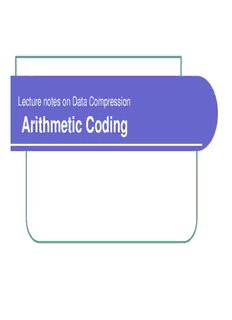
Lecture notes on Data Compression Arithmetic Coding PDF
Preview Lecture notes on Data Compression Arithmetic Coding
Lecture notes on Data Compression Arithmetic Coding Contents Huffman coding revisited (cid:122) History of arithmetic coding (cid:122) Ideal arithmetic coding (cid:122) Properties of arithmetic coding (cid:122) 2 Huffman Coding Revisited -- How to Create Huffman Code Construct a Binary Tree of Sets of Source Symbols. (cid:122) Sort the set of symbols with non-decreasing probabilities. (cid:122) Form a set including two symbols of smallest probabilities. (cid:122) Replace these by a single set containing both the symbols (cid:122) whose probability is the sum of the two component sets. Repeat the above steps until the set contains all the symbols. (cid:122) Construct a binary tree whose nodes represent the sets. (cid:122) The leaf nodes representing the source symbols. Traverse each path of the tree from root to a symbol, (cid:122) assigning a code 0 to a left branch and 1 to a right branch. The sequence of 0’s and 1’s thus generated is the code for the symbol. 3 Properties of Huffman Coding Huffman codes are minimum redundancy codes for a (cid:122) given probability distribution of the message. Huffman coding guarantees a coding rate l within one (cid:122) H bit of the entropy H. Average code length l of the Huffman coder on the source S is (cid:122) H bounded by H(S)<= l <= H(S) + 1 H Studies showed that a tighter bound on the Huffman (cid:122) coding exists. Average code length l < H(S) + p +0.086, where p is the (cid:122) H max max probability of the most frequently occurring symbol. So, if the p is quite big (in case that the alphabet is small and the (cid:122) max probability of occurrence of the different symbols is skewed), Huffman coding will be quite inefficient. 4 Properties of Huffman Coding (continued) Huffman code does not achieve ‘minimum redundancy’ (cid:122) because it does not allow fractional bits. Huffman needs at least one bit per symbol. (cid:122) For example, given alphabet containing two symbols with (cid:122) probability: p = 0.99, p = 0.01 1 2 The optimal length for the first symbol is: −log(0.99) = 0.0145 (cid:122) The Huffman coding, however, will assign 1 bit to this (cid:122) symbol. If the alphabet is large and probabilities are not (cid:122) skewed, Huffman rate is pretty close to entropy. 5 Properties of Huffman Coding (continued) If we block m symbols together, the average code (cid:122) length l of the Huffman coder on the source S is H bounded by H(S)<= l <= H(S) + 1/m H However, the problem here is that we need a big (cid:122) codebook. If the size of the original alphabet is K, then the size of the new code book is Km. Thus, Huffman’s performance becomes better at the (cid:122) expense of exponential codebook size. 6 Another View of Huffman Coding Huffman code re-interpreted (cid:122) here by mapping the symbols to binary subintervals of [0,1) at the base symbol probability code fraction value of the subintervals. W 0.5 1 0.1 X 0.25 01 0.01 Y 0.125 001 0.001 The code words, if regarded as (cid:122) Z 0.125 000 0.000 binary fractions, are pointers to the particular interval in the binary code. An extension to this idea is to (cid:122) encode the symbol sequence as a subinterval leads to arithmetic coding. 7 Arithmetic Coding The idea is to code string as a binary fraction (cid:122) pointing to the subinterval for a particular symbol sequence. Arithmetic coding is especially suitable for small (cid:122) alphabet (binary sources) with highly skewed probabilities. Arithmetic coding is very popular in the image and (cid:122) video compression applications. 8 A Bit of History The idea that code string can be a binary fraction (cid:122) pointing to the subinterval for a particular symbol sequence is due to Shannon [1948]; and was used by Elias [1963] to successive subdivision of the intervals. Shannon observed that if the probabilities were (cid:122) treated as high precision binary numbers, then it may be possible to decode messages unambiguously. David Huffman invented his code around the same (cid:122) time and the observation was left unexplored until it re-surfaced in 1975. 9 A Bit of History (continued) The idea of arithmetic coding was suggested by (cid:122) Rissanen [1975] from the theory of enumerative coding by Pasco [1976]. The material of this notes is based on the most (cid:122) popular implementation of arithmetic coding by Witten, etc., published in Communications of the Association for Computing Machinery (1987). Moffat, etc (1998) also proposed some improvements (cid:122) upon the 1987 paper; however, the basic idea remains same. 10
Description: